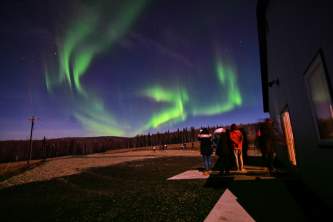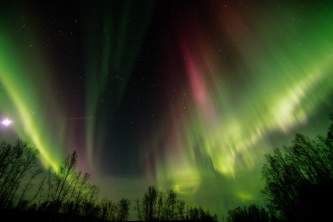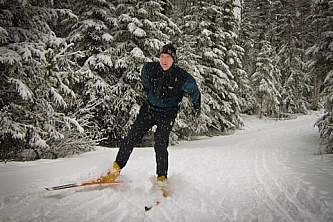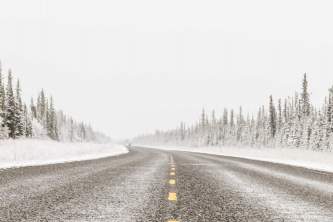Kory's Fairbanks Aurora Viewing Tips
Seeking aurora in Fairbanks? Here are insider tips from Aurora Pointe Activity Center.
Aurora expert Kory Eberhardt has spent decades helping people achieve their quest to witness the aurora. He oversees aurora tours on his family homestead in the hills northeast of Fairbanks at A Taste of Alaska lodge and Aurora Pointe Activity Center.
- Typically, the most common time to see the aurora is from 11:00 pm to 3:00 am. However, times always vary and there is never a guarantee to when, or if, you will see the aurora.
- Ignore all weather forecasts and aurora predictions. Nature is out of everyone’s control. The only thing you can control is the time you are awake and actively searching the sky.
- The best way to see the aurora is to get outside and look. Gear up and step outdoors.
- When attempting to view the aurora around other watchers, please be courteous in your use of artificial lights. Turn off lights at your lodging or your car. Try to not shine your flashlight directly at anyone trying to take photographs. Be aware of tripods and don’t walk in front of cameras.
- At first look directly overhead. The aurora runs from the northwest to the southeast. If the aurora really gets going, it will be all over the sky and clearly visible. If nothing stands out to you right away, then start moving further into the open for a better viewpoint.
Kory also recommends these great viewing tips from Explore Fairbanks:
- Intensity varies daily, with the best displays from late evening to early morning hours.
- Aurora will be visible an average of four out of five nights when the sky is clear and dark enough.
- If you stay a minimum of three nights and are actively out during the evening hours, your chance of seeing the aurora is more than 90 percent.
- A vibrant green is the most common aurora color but the spectrum includes red, magenta, yellow and white.
- The aurora takes on different shapes such as curtains, bands, rays and coronas.
- The aurora’s movement across the sky ranges from slow and languid to sudden and swift.
- The twelve-year aurora cycle does not significantly impact northern lights viewing in Fairbanks and areas north of the Alaska Range because of their position under the “Auroral Oval.”
- A full moon does not obscure the light of the aurora when viewed beneath the “Auroral Oval. In fact, the full moon often enhances the contrast between the scenery, the snow and the aurora.
- Locate a dark area with minimal light pollution. Point your camera to the northern sky and compose your medium-distance foreground with a fixed object such as trees, hills or a cabin.
- Use a digital camera with manual settings and a solid tripod. Bring extra camera batteries and a flashlight and dress for extended times outdoors.
- Manually set your camera on its highest ISO setting, widest focal point and lowest aperture. Expose each shot for approximately 5 to 10 seconds. Longer exposures will result in brighter images, but stars will streak and the aurora will soften. Short exposures may have sharper detail but dimmer images.
- Every aurora and camera is distinctive, so experiment with different settings and exposure times to get the best shot. Review your shots and adjust the settings as needed.
For more aurora information, predictions and real-time conditions.
- The best all-sky webcam from the University of Alaska Fairbanks Geophysical Institute.
- A webcam at Explore.org.
- The aurora forecast from the UAF Geophysical Institute.
- NASA’s Space Weather Prediction Center has lots of aurora information, including a 30-minute forecast and three-hour outlook.




